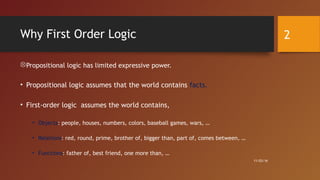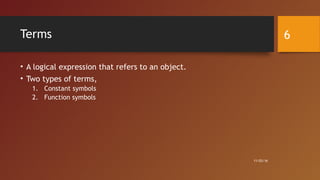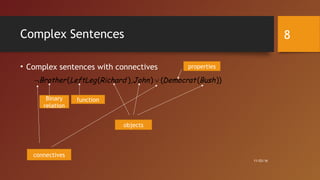First order logic in knowledge representation
- 1. FIRST ORDER LOGIC IN KNOWLEDGE REPRESENTATION Ishara Athukorala EP 1310 11/03/16 1
- 2. Why First Order Logic Propositional logic has limited expressive power. • Propositional logic assumes that the world contains facts. • First-order logic assumes the world contains, • Objects: people, houses, numbers, colors, baseball games, wars, … • Relations: red, round, prime, brother of, bigger than, part of, comes between, … • Functions: father of, best friend, one more than, … 11/03/16 2
- 3. Syntax of First Order Logic • Constants: john,apples • Predicates: likes(john, apples) • Functions: likes(john, fruit_of(apple_tree)) • Variables: likes(X, apples) • Connectives:¬, ⇒, ∧, ∨, ⇔ • Equality:= • Quantifiers: True for all objects (Universal) Exists at least one object (Existential) 11/03/16 3
- 4. Relations • Some relations are properties: they state some fact about a single object: Round(ball), Prime(7). • n-ary relations state facts about two or more objects: Married(John,Mary), LargerThan(3,2). • Some relations are functions: their value is another object: Plus(2,3), Father(Dan). 11/03/16 4
- 5. Models for FOL: Graphical Example 11/03/16 5
- 6. Terms • A logical expression that refers to an object. • Two types of terms, 1. Constant symbols 2. Function symbols 11/03/16 6
- 7. Atomic Sentences • Atomic sentences state facts using terms and predicate symbols P(x,y) interpreted as “x is P of y”. Examples: • Brother_of(Mary,Pete) is false • Brother_of(Pete,Brother(Pete)) is True. Binary relation Function 11/03/16 7
- 8. Complex Sentences • Complex sentences with connectives ( ( ), ) ( ( ))Brother LeftLeg Richard John Democrat Bush¬ ∨ objects connectives Binary relation function properties 11/03/16 8
- 11. Some Examples… • All purple mushrooms are poisonous. ∀x (mushroom(x) ∧ purple(x)) → poisonous(x) • Every gardener likes the sun. ∀x gardener(x) → likes(x,Sun) • Clinton is not tall. ¬tall(Clinton) 11/03/16 11
- 12. Some Examples… • “On Mondays and Wednesdays I go to John’s house for dinner” ∀X.((is_mon(X) V is_wed(X)) -> eat_meal(me,houseOf(John),X)) • “Every rose has a thorn” ∀X(rose(X) -> EY.(has(X,Y) ∧ thorn(Y))) 11/03/16 12
- 13. References • Benson Mates, Elementary Logic, OUP, New York 1972 (Library of Congress Catalog Card no.74-166004) • Elliot Mendelson, Introduction to Mathematical Logic, Van Nostran Reinholds Company, New York 1964 11/03/16 13














